The Department of Urology at the Icahn School of Medicine sees patients from around the region, country and globe seeking our expertise in advanced diagnostic and treatment procedures. Our robotics program is one of the most robust in the world and our surgeons are sought out by their peers to handle a broad range of complex and challenging cases. We also work as members of interdisciplinary teams with our colleagues throughout the Mount Sinai Health System to achieve the best outcomes for our patients.
Complex Cases
Case 1
Renal Cell Carcinoma with Atrial Tumor Thrombus Extending to the Right Atrium Diagnosed During Pregnancy
Summary
A multidisciplinary team comprised of Urology, Fetal Medicine, Cardiothoracic Surgery, Hepatobiliary surgery, Pulmonology Critical Care, Anesthesia, and Obstetrics was assembled May, 2016 to remove a renal cell carcinoma (RCC) extending into the right atrial thrombus of a woman at 31 weeks of gestation. The concerns facing our team were sizable: fetal and maternal morbidity and mortality; risk of a thromboembolic event (increased by the presence of lupus anticoagulant antibodies, active malignancy and pregnancy) and intraoperative hemorrhage. Because of the rarity of such cases (4-10 percent of patients having RCC have an extension into the vena cava, as shown below) and only 106 reports of RCC during pregnancy were recorded as of 2015) and the unique presentation of this case (no such cases of level IV tumor thrombus reported in the literature to date), no management guidelines exist. Timing of surgery and approach are paramount and must be individualized for successful outcomes. In this case, our team staged a cesarean section followed by an open right radical nephrectomy with IVC thrombectomy, right atrium and ventricle exploration and pulmonary artery embolectomy on cardiopulmonary bypass.
| Group | I | II | III | IV |
| Level of Tumor Thrombus Involvement | Renal vein only | Infrahepatic Inferior Vena Cava | Retrohepatic or suprahepatic Vena Cava | Extension to the Right atrium |
Renal Cell Carcinoma with Atrial Tumor Thrombus Classification
At the present date, there exists only one other report of RCC with IVC tumor thrombus diagnosed during pregnancy published in 2013.1 In this case, the tumor thrombus extended to the level of the infrahepatic IVC (Group II).
Case Highlights
A 37-year-old woman at 24 weeks of gestation was incidentally found to have a 6.0 x 6.0 cm solid mass in the lower pole of the right kidney on fetal ultrasound, subsequently confirmed by magnetic resonance imaging (MRI). At 29 weeks of gestation, the patient presented to an outside hospital for shortness of breath Doppler ultrasound of the bilateral lower extremities demonstrated a right common femoral vein thrombus. Ventilation-perfusion (VQ) scan was indeterminate for pulmonary embolus. Blood tests indicated that the patient was lupus anticoagulant positive so she was discharged on hospital day 5 on therapeutic enoxaparin. Nine days later at 30 weeks of gestation, the patient presented again back to an outside hospital with worsening dyspnea, tachycardia, and anemia (hemoglobin of 7.0). Transthoracic echocardiogram (TTE) at this time revealed a previously undiagnosed right atrial mass, concerning for level IV tumor thrombus from her RCC
Given her prior consultation with urologic oncologist, Dr. Reza Mehrazin, she was transferred to the Mount Sinai Medical Center for higher level care.
A multidisciplinary team consisting of specialists in urologic oncology, cardiothoracic surgery, hepatobiliary surgery, obstetrics, maternal fetal medicine, anesthesia, cardiothoracic anesthesia and pulmonary critical care was constructed for the care of the patient and her fetus. The multidisciplinary team decided to stage the procedures in the best interest of survival for both the patient and her fetus: delivery of the fetus by cesarean section at 30 weeks of gestation and subsequent right radical nephrectomy, IVC thrombectomy, and right atrial thrombectomy on cardiopulmonary bypass when the patient’s hemodynamic status was optimized. The patient underwent an uncomplicated cesarean delivery of a healthy preterm neonate at 31 weeks of gestation. Subsequently, MRI of the abdomen and pelvis confirmed that the right renal mass extended into the right renal vein, inferior vena cava (IVC) and right atrium (Level IV IVC thrombus), with extensive retroperitoneal periportal and paraspinal venous collaterals (Figures 1 and 2).
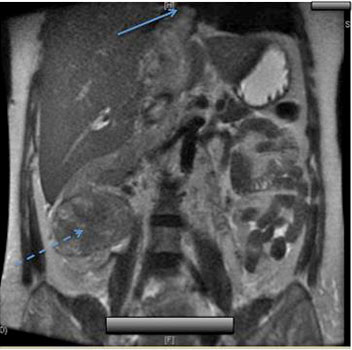
Figure 1. Magnetic resonance imaging at 31 weeks gestation showing a mass in the lower pole of right kidney and tumor thrombus extending into IVC above the level of the diaphragm.
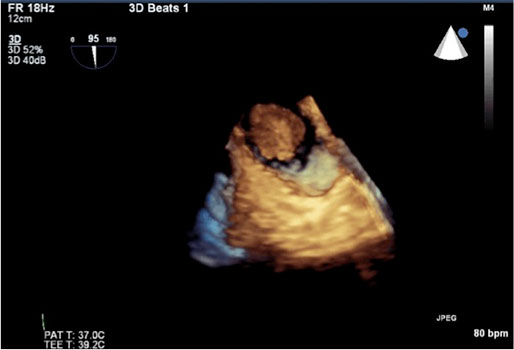
Figure 2. Intraoperative transesophageal echocardiography showing the location of the tumor thrombus
Four days postpartum, when the patient was medically optimized, a team of surgeons led by Dr. Reza Mehrazin, Assistant Professor of Urology at the Icahn School of Medicine at Mount Sinai performed open right radical nephrectomy vena cava thrombectomy, right atrium and ventricle exploration, and pulmonary artery embolectomy on cardiopulmonary bypass.
During tumor thrombectomy it was noted that tumor thrombus was also extending into the contralateral renal vein. Pathologic evaluation of the specimen revealed a Fuhrman nuclear grade 2 clear cell RCC with tumor thrombus of the bilateral renal veins, IVC, and right atrium.
On postoperative day 8, the patient was discharged home in stable condition. At four postoperative weeks, a CT scan of the chest, abdomen, and pelvis was performed revealing a normal left kidney with no renal mass, a patent intrahepatic IVC.
At eight post surgical weeks, the patient and infant are doing well. The patient is closely monitored by urologic oncology and medical oncology, with plan to start either anti-VEGF (sunitinib or pazopanib) or anti-PD-1 (nivolumab) therapy.
Reference
1) Khaled H et al., Review on renal cell carcinoma and pregnancy: A challenging situation. JAdvRes(2016), http://www.sciencedirect.com/science/article/pii/S2090123216300091
Meet the Team:
- Jeffrey Bander, MD: Assistant Professor, Cardiology
- Umesh Gidwani, MD: Associate Professor, Medicine, Pulmonary, Critical Care and Sleep Medicine
- Matthew Levin, MD: Assistant Professor Anesthesiology
- Reza Mehrazin, MD: Assistant Professor of Urology
- Maria Mella, MD: Professor, Obstetrics, Gynecology and Reproductive Science
- Ramchandara Reddy, MD: Assistant Professor, Cardiovascular Surgery
- Joanne Stone, MD: Assistant Professor, Obstetrics, Gynecology and Reproductive Science
- Myron Schwartz, MD: Professor, Hepatobiliary Surgery
Case 2
Robotic Surgery for Treatment of Chyluria
Case Summary
Chyle is a milky lymphatic fluid that is normally formed in the small intestine to aid in the absorption of dietary fats. Occasionally, chyle leaks into the kidney, ureter, or bladder, which results in chyluria. Chyluria is most commonly caused by the parasite Wuchereria bancrofti and is therefore extremely rare in the USA. This is the case of a 75-year-old Indian female from the USA who was diagnosed with non-parasitic, persistent chyluria and treated with right robotic ureterolysis, renal hilar dissection and intraperitonealization of the ureter at the Mount Sinai Health System by Dr. Michael A. Palese, Chair of Urology, Mount Sinai Beth Israel and Director, Minimally Invasive Urology.
The use of robotic surgery for treating chyluria was first suggested in the literature in 2009. Sharma and Hemal briefly mention that robotics can be used for nephrolympholysis, ureterolympholysis, hilar vessel stripping, fasciectomy, and nephropexy and should therefore be able to treat chyluria [4]. However, no cases had been reported in the literature confirming this hypothesis that robotic surgery could be used to treat chyluria. We believe this is the first reported case for the use of robotic surgery in the treatment of persistent chyluria.
Case Highlights
A 75-year-old female of Indian descent from the USA presented with a known history of persistent chyluria. She had been experiencing chyluria consistently for 10 months, with a previous episode of chyluria 25 years ago that spontaneously ceased.
The patient had no recent history of travel outside the USA. She had a past medical history of hypercholesterolemia, ischemic colitis, and left ductal breast carcinoma in situ for which she received radiation therapy. Her past surgical history included cardiac ablation for SVT, left breast lumpectomy, and scleropathy. She denied any surgery to the kidney or genitourinary tract. She had no family history of chyluria. She denied any alcohol, smoking, or drug abuse history. A right retrograde pyelogram showed narrowing of the right ureter (Fig. 1), and CT scan demonstrated moderate hydronephrosis (Fig. 2). MRI of the abdomen was not performed since several CT scans were taken over a 7-year duration.

Fig. 1
Pyelogram of the right ureter

Fig. 2
CT scan
During her initial evaluation, she underwent a primary ureteroscopy with evaluation of her right kidney and ureter with noted chylous-appearing fluid coming from the right urinary tract. Significant inflammation was noted throughout the ureter, especially at the level of the proximal ureter. She remained in remission for 5 months following the ureteroscopy, until she began to experience chyluria, almost daily and typically during the afternoon (Fig. 3). She also developed significant right flank pain, edema, and small blood clots in her urine. Her urinalysis revealed high triglycerides, high proteinuria, and a negative evaluation for filariasis or acid-fast bacilli.
The treatment of chyluria includes both non-surgical and surgical options, depending on the severity of the disease (Table 1) [1, 2-4 ]. The most conservative measures include fat-restricted diets (since fat absorption results in chyle formation), supportive treatment, and prescribing diethylcarbamazine (5]. Administering povidone iodine or silver nitrate has also been shown to be effective for managing chyluria patients (6). If the chyluria is more severe or persistent, then more radical measures can be taken such as a lympho-venous disconnection with surgery, or in severe cases nephrectomy and renal autotransplantation [4]. The condition of our patient had significantly worsened several months before surgery and she requested definitive management as soon as possible, which is why robotic surgery was ultimately performed.
Table 1
List of non-surgical and surgical treatments for chyluria
|
Non-surgical treatments |
Surgical treatments |
|
Dietary modifications |
Lympho-venous disconnection |
|
Diethylcarbamazine |
Patna operation |
|
Supportive treatment |
Omental wrapping |
|
Scleropathy |
Renal autotransplantation |
|
Permanent relief |
Nephrectomy |
|
Silver nitrate |
Cockett and Goodwin procedure |
|
Povidone iodine |
Microsurgical procedures |
|
Combination therapy |
Lymphangiovenous anastomosis |
|
Heat clearing and hemostatic treatment |
Lymph node–saphenous vein anastomosis |
|
Somatostatin therapy |
Laparoscopic procedures |
|
Total parenteral nutrition |
Retroperitoneoscopic single-site renal pedicle lymphatic disconnection (RPSS-RPLD) |
|
|
Robotics |
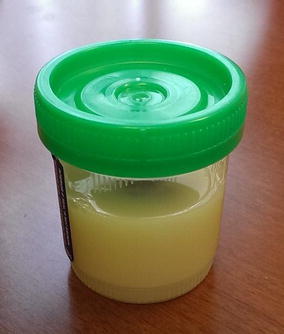
Fig. 3
Chyle fluid
The patient underwent a right robotic ureterolysis, renal hilar dissection, and omental fat wrapping of the ureter and hilum. A standard robotic approach was taken with the use of a four-arm robotic configuration. The renal hilum was dissected anteriorly with exposure of the renal artery and vein. All potential chylo-venous bridges were disrupted at this level. Finally, omental fat was wrapped around the proximal ureter and around the renal hilum with care not to obstruct the ureter or injure the hilum.
Intraoperative findings indicated extensive vascular proliferation around the hilum and ureter, along with substantial adhesions and inflammation. Many chylous-appearing connections were also present. After the operation, the patient had clear yellow urine and experienced no complications. The patient was discharged 3 days post surgery. The mean operative time was 106 min and the estimated intraoperative blood loss was 50 mL. At a 6 months follow-up, the patient did not report a single episode of chylous urine.
References:
1. Sachit S, AshokKumar H (2009) Chyluria-an overview. Nephro Urol Mon 1(1, Summer):14–26
2. Cortvriend J, Van Nuffel J, Van den Bosch H, Van Erps P (1998) Non-parasitic chyluria: a case report and review of the literature. Acta Urol Belg 66(3):11–15 PubMed
3.Zhuo W, Chai J, Xu T, Wu W, Yang S, Tan J (2013) Retroperitoneoscopic single-site renal pedicle lymphatic disconnection for the treatment of serious filarial chyluria. Can J Urol 20(2):6726–6729 PubMed
4. Brunkwall J, Simonsen O, Bergqvist D, Jonsson K, Bergentz SE (1990) Chyluria treated with renal autotransplantation: a case report. J Urol 143(4):793–796 PubMed
5. Panicker KN, Arunachalam N, Kumar NP, Prathibha J, Sabesan S (1996) Efficacy of diethylcarbamazine-medicated salt for microfilaraemia of Brugia malayi. Natl Med J India 10(6):275–276
6. Sinha RK, Ranjan N, Singh N, Amit K (2015) Chyluria: a scourge of our region. BMJ Case Rep 2015:bcr2014209188 CrossRefPubMed
Meet The Team:
- Naman Barman: Student, Icahn School of Medicine at Mount Sinai
- Michael Palese, MD: Professor Urology, Chair, Department of Urology, Mount Sinai Beth Israel
- Allison Polland: Former Resident, Department of Urology, Department of Urology
- Joseph Vassalotti: Associate Clinical Professor, Department of Urology
Anmol Guptaa, Katherine Brewera, Michael Palesea
a Icahn School of Medicine at Mount Sinai, Department of Urology, 1 Gustave L. Levy Pl, New York, NY 10029, USA
Abstract
Renal auto-transplantation was first performed in 1963 for the repair of a proximal ureteral injury sustained during aortic surgery, with reimplantation of the kidney into the ipsilateral iliac fossa. More recently, with the aid of advancements in microvascular surgery and improved renal preservation during transplant, the use of renal auto-transplant has been utilized in a variety of urologic applications. It can be used as part of reconstructive surgery for patients with extensive ureteral stricture disease, significant ureteral loss, or complex vascular disease in which renal preservation is essential. Literature suggests a 90% long-term success rate with a >6 year follow-up for complex conditions. As in this case report, several authors have utilized laparoscopic nephrectomy with ex vivo repair and autotransplant. We present a case of a 64 year-old African American female who presented with a chronic left distal ureteral stricture secondary to a history of recurrent nephrolithiasis and a prior distal ureteral re-implant with psoas hitch. The patient successfully underwent a left renal autotransplant.
Introduction
The incidence of ureteral stricture disease is on the rise due to increased use of ureteroscopy, radiation therapy, urinary diversions, renal transplantation and other iatrogenic causes. For patients with lengthy strictures, often the only treatment options include ureteral stent exchanges, management with nephrostomy tubes or ileo-interpositioning, also known as ileoureter. However, these modalities can significantly impact patient quality of life. The use of renal autotransplant, on the other hand, is not fraught with the metabolic complications associated with ileoureter or the constant need ureteral stent exchanges. Thus, it serves as a viable alternative for many patients. Risk factors for complicated autotransplantation include hypertension, microalbuminuria, and poorly controlled diabetes mellitus. In this report, we present a patient with a chronic distal ureteral stricture secondary to recurrent nephrolithiasis and prior distal ureteral re-implant with psoas hitch.
Case Presentation
A female in her 60s who presents with a past medical history of hypertension, diabetes mellitus, hyperlipidemia and chronic left distal ureteral stricture secondary to a history of recurrent nephrolithiasis and prior distal ureteral re-implant with psoas hitch performed at an outside institution for management of distal ureteral stricture. Her ureteral stricture disease had been managed with chronic ureteral stent changes that were complicated by recurrent urinary tract infections. After discussing various reconstruction options, including chronic stent exchanges, a possible ileal ureter, and repeat psoas hitch and ureteral implant, the patient agreed to pursue laparoscopic left renal autotransplantation with possible bladder reconstruction.
The procedure performed is comprised of three main parts: 1) living donor nephrectomy, 2) backtable preparation of left kidney for auto-transplantation, and 3) renal autotransplantation into the iliac fossa with neoureterocystostomy. Pre-operative evaluation demonstrated that the patient had a >4 cm left (proximal/mid/distal) ureteral stricture status post previously failed ureteral re-implant with Psoas hitch. The case was performed in collaboration with the renal transplant and urology surgeons.

Figure 1: Pre-operative cystoscopy image depicting left proximal ureteral stricture
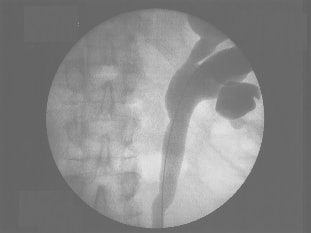
Figure 2: Pre-operative cystoscopy image showing evidence of hydroureteronephrosis
Intraoperatively, a severely stenosed left ureter was identified lateral to the left gonadal vein. Ureterolysis of the distal left ureter was performed to the level of the previous psoas hitch. The adrenal gland was separated from the kidney. A Pfannenstiel incision was made, the renal artery and vein were stapled and the kidney was extracted via the paramedian hand port. Extraction time was approximately 2 minutes.
In a separate back table procedure, the kidney was flushed with chilled preservative solution and chilled in a sterile basin on ice. There was a single artery and vein identified. Small side branches of the vein were ligated. The native kidney was re-delivered into her abdominal cavity intact through the lower Pfannenstiel incision. A renal auto-transplantation to the left iliac fossa was then made.
An adequate length of artery and vein were identified, both of good quality and caliber. The patient's left kidney was then reimplanted in the pelvis to the left external iliac artery and vein. The kidney was reperfused by first releasing the venous clamp followed by the arterial clamps. The kidney reperfused well immediately. The vein was soft, the artery had a good thrill, and there was good hemostasis. The ureter was identified and healthy appearing with good urine output An end-to-side neoureterocystostomy was performed over a 10cm double-J stent with running 5-0 PDS suture. The kidney began making urine immediately.
Estimated blood loss during the transplantation portion of the procedure was approximately 75mL and the patient received approximately 1500mL of crystalloid during the transplantation portion. The cold ischemia time for the kidney was less than 45 minutes, the warm ischemia time was approximately 21 minutes.
Following completion of the auto-transplantation, the pneumoperitoneum was reestablished and diagnostic laparoscopy was performed to inspect the operative field. No pooling of blood was noted, and the renal vein and renal artery stumps were well controlled and not bleeding. The patient received no blood products and was taken from the operating room to the recovery room in stable condition.
Ultrasound imaging postoperatively showed a transplanted kidney 10.4 cm in length with mild fullness in the renal pelvis but no visualized perinephric collection. The iliac artery and vein were confirmed patent with a peak systolic velocity of 218 cm/s. The main renal artery showed a resistive index of 0.86, while intrarenal arteries ranged from resistive indices of 0.76-0.79. Arcuate arteries ranged from 0.72-0.75 with no reversal of diastolic flow.
Figure 3:
Various ultrasound images taken post-operation day 1

Image 3a:
The anastomosis is patent with a peak velocity of 218 m/s

Image 3b:
The transplanted kidney visualized measures 10.4 cm in length
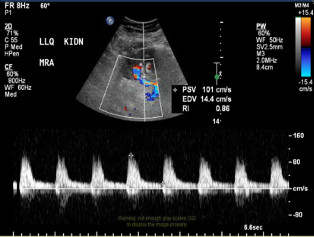
Image 3c:
Patent main renal artery with a resistive index of 0.86.
The patient’s post-operative hospital course was uncomplicated. Creatinine and urinary output remained stable throughout admission; the patient voided freely following Foley removal on post-operative day 3, pain was well tolerated with oral medication, and bowel movements initiated prior to discharge 6 days post-operation. Follow-up two weeks post-op and three months after the procedure was normal with no complications. The standard urinalysis and culture were done to rule out infection.
Ultrasound imaging confirmed a proper repair. No evidence of frank hydronephrosis, abnormal echogenicity, or perinephric masses/fluid was seen. Peak systolic velocity was 155 cm/s in the left iliac artery, 421 cm/s at the origin of the renal artery of the transplant kidney, and 223 cm/s at the mid renal artery. Resistive index was 0.73 at the inferior and mid levels of the transplanted kidney, and 0.70 at the superior level.
Discussion
Renal auto-transplantation was first performed in 1963 for the repair of a high ureteral injury during aortic surgery, with reimplantation of the kidney into the ipsilateral iliac fossa.1 More recently, with the aid of microvascular surgery advancement and improved renal preservation during transplant, renal auto-transplant has been utilized in a variety of urologic applications. Surgeons can implement this as a reconstruction option for the surgical management of patients with extensive ureteral stricture disease, ureteral loss, or complex vascular problems in which renal preservation is essential.
According to Alzhar et al, other indications for renal autotransplantation include renal artery aneurysms, fibromuscular dysplasia, Takayasu disease, and atherosclerosis. Autotransplant has also been used where percutaneous transluminal angioplasty or in vivo repair has not been possible.2 Other published data suggests a greater 90% long-term success rate ( >6-year follow-up) for complex ureteral or renal conditions that require preservation of renal parenchyma (i.e. when the contralateral kidney is at risk for dysfunction or absent).3 Renal auto-transplantation has been described in the literature for complex pathology, including, 1) extensive ureteral stricture disease; 2) significant ureteral loss secondary to trauma or malignancy; and 3) complex renal vascular lesions requiring ex vivo repair such as renal artery aneurysm, among other structural abnormalities.
Careful patient selection and followup is mandatory to ensure success. Adequacy of the vascular supply at the site of intended auto-transplantation (typically the iliac vessels) must be ensured prior to surgery. Risk factors to consider include poorly controlled diabetes mellitus, hypertension, and microalbuminuria. It is also important to minimize ischemia time. In the case of this patient total ischemia time was 45 minutes while warm ischemia time was 21 minutes. This is comparable to that of other studies involving renal autotransplant. In one particular study involving six complex patients who all had uneventful intraoperative courses, a mean cold ischemia time of 41 minutes (range: 34-55 min) was generated. 4
Consideration for auto-transplantation can be made in patients with proximal ureteral obstruction that cannot be managed with bladder-based methods of repair (Boari flap, with or without psoas hitch). Renal auto-transplantation avoids the risks of mucus production, stone formation, infection, and stricture associated with reconstruction options such as the replacement of the ureter with ileum.3
While auto-transplantation does carry its own set of potential complications, including thrombosis, stenosis, vascular leak, and urine leak, alternatives, which include total nephrectomy, chronic ureteral stent exchanges, an ileal ureter, or ureteral implants also have their associated risks. Total nephrectomy is associated with high morbidity and necessitates life-long dialysis barring a donor kidney. Chronic ureteral stent exchanges, which can take place every 3 months in some patients, and ureteral implants can result in recurrent urinary tract infections, hematuria, chronic stent pain, and significant decline in quality of life.5 Ileal ureter puts patients at risk for severe metabolic complications.
Follow-up of renal autotransplantation patients involves standard a post-op visit two weeks after surgery and monitoring for urinary symptoms (infections, leaks, pain, etc.) as well as visualization of the repair via ultrasound. The patient presented in this case has been compliant with medications and follow-up visits with no complications.
Conclusion
Renal autotransplant may be useful in preventing permanent kidney loss in circumstances where more conventional methods, such as chronic stent changes, ureteral implants, and ileal ureter, do not sufficiently address ureteral stricture disease. Risk factors to consider in the selection of patients include poorly controlled diabetes mellitus, hypertension, and microalbuminuria. Associated surgical complications include thrombosis, stenosis, vascular leak, and urine leak. However, literature suggests greater than 90% of patients receiving renal autotransplant experience long-term success in the treatment of complex ureteral and renal disease.
Conflicts of Interest
None
Acknowledgements:
None
References
- Hardy, J. D. (1963). High ureteral injuries. Management by autotransplantation of the kidney. JAMA, 184, 97-101.
- Azhar, B., Patel, S., Chadha, P., & Hakim, N. (2015). Indications for renal autotransplant: an overview. Exp Clin Transplant, 13(2), 109-114.
- Tran, G., Ramaswamy, K., Chi, T., Meng, M., Freise, C., & Stoller, M. L. (2015). Laparoscopic Nephrectomy with Autotransplantation: Safety, Efficacy and Long-Term Durability. J Urol, 194(3), 738-743. doi:10.1016/j.juro.2015.03.089
- Hau, H. M., Bartels, M., Tautenhahn, H. M., Morgul, M. H., Fellmer, P., Ho-Thi, P., . . . Jonas, S. (2012). Renal autotransplantation--a possibility in the treatment of complex renal vascular diseases and ureteric injuries. Ann Transplant, 17(4), 21-27.
- Soto Soto, J., Phillips, M., Cernigliaro, J., & Haley, W. (2012). Renal autotransplantation for iatrogenic high-grade ureteric stricture. Case Rep Urol, 2012, 259527. doi:10.1155/2012/259527
Meet the Team
- Dr. Michael Palese, Professor Urology, Chair, Department of Urology, Mount Sinai Beth Israel
- Dr. Sander Florman, Transplant Surgeon, Director of Recanti/Miller Transplant Institute
- Dr. Katherine Brewer, Urology Chief Resident
- Dr. Chiara Rocha, Transplant Surgery Resident
- Anmol Gupta, Medical Student, Icahn School of Medicine at Mount Sinai